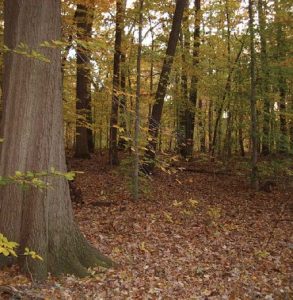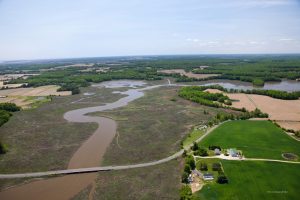Green infrastructure is a nature-based approach that uses a combination of engineering and nature’s own systems to address environmental challenges like erosion, flooding, and air and water pollution.
Green infrastructure is not limited to engineered or human-built constructions. At the landscape scale, green infrastructure includes protected areas of natural ecosystems like forests, wetlands, and natural shorelines and floodplains.
The basic concept behind green infrastructure at the landscape scale is to link large ecologically significant natural areas with natural corridors that protect water quality, provide habitat for resident and migratory species, and increase the resilience of the landscape to storms and flooding. Green infrastructure at the landscape scale can also buffer homes, businesses, buildings, and roads from the impacts of extreme weather and long-term climate change.
The interconnected nature of green infrastructure at the landscape level allows these natural ecosystems to function at a higher level. When areas of natural habitat are fragmented, in small or isolated pieces, they may still provide some benefits as green infrastructure, but retaining connectivity can help to offset the functional losses caused by fragmentation.
 Forests include the forest floor (soil, organic matter, and small plants such as grasses and wildflowers), the understory or shrub layer (small trees or bushes), and the canopy (the leaves and branches of the trees that dominate the forest). Forests cover approximately 30 percent of Delaware’s land area with a diverse variety of forest community types.
Forests include the forest floor (soil, organic matter, and small plants such as grasses and wildflowers), the understory or shrub layer (small trees or bushes), and the canopy (the leaves and branches of the trees that dominate the forest). Forests cover approximately 30 percent of Delaware’s land area with a diverse variety of forest community types.
Among many other benefits, forest environments protect wildlife, absorb and filter water, and store carbon in their leaves, branches and roots, reducing the amount of carbon dioxide in the atmosphere. They also foster an enjoyment and appreciation of the outdoors, providing an environment for hiking, bird-watching, and other outdoor activities.
Delaware’s forested lands have declined greatly since European settlement in the 17th century. Precolonial forests covered an estimated 1.1 million acres—roughly 90 percent of the state’s land area. Today, approximately 371,000 acres of the state is in forest habitat.
Although the state’s total forest acreage has remained relatively stable in the past three decades, forest assessments indicate that the average forest tract size is declining and forest habitat is becoming more fragmented, largely as a result of residential and commercial development. The Delaware Forest Service estimates that only 20 percent of all forest parcels are 500 acres or larger. Protecting and managing the state’s remaining forest resources is essential to green infrastructure at the landscape scale.
 Wetlands are natural transition areas between aquatic and upland habitats that serve as green infrastructure at the landscape scale. Primarily low and marshy, wetlands may be saturated, submerged, or appear dry part of the year, with soils that support unique plant and animal life. Wetlands can be found in fresh or salt water, and vary widely in vegetation type, geographic location, and connectivity to other wetlands and other landforms.
Wetlands are natural transition areas between aquatic and upland habitats that serve as green infrastructure at the landscape scale. Primarily low and marshy, wetlands may be saturated, submerged, or appear dry part of the year, with soils that support unique plant and animal life. Wetlands can be found in fresh or salt water, and vary widely in vegetation type, geographic location, and connectivity to other wetlands and other landforms.
Wetlands provide ecosystem services like water filtering and preventing erosion, and harbor tremendous biodiversity.
A number of wetland types are found in Delaware, which include seasonal freshwater wetlands such as freshwater tidal marshes, swamp forests, floodplain hardwood swamps, wet meadows, and coastal plain ponds. Salt and brackish marsh types include salt marshes, scrub-shrub wetlands, Atlantic white cedar swamps, and bald cypress swamps.
Delaware has approximately 320,000 acres of wetlands, about one-third of which are tidal wetlands. Since European settlement, the state has lost about 54 percent of its historic wetlands. This significant loss of wetlands underscores the importance of protecting the remaining wetland habitats, and enhancing and restoring wetlands where possible.
 The term “shoreline” includes the ocean coastline, bay shorelines, and the tidal portion of rivers and creeks. It is made up of wetlands, upland and riparian lands, nearshore waters, and in some cases beaches and dunes. Floodplains are low-lying lands adjacent to rivers, streams, ponds, lakes, and oceans. Both shorelines and floodplains perform many ecological functions, such as improving water quality, supporting wildlife habitat, protecting uplands from erosion, and providing a buffer from the impacts of storms and flooding. Flooding, which occurs naturally in river and coastal areas, causes the deposit of sediments that contribute to a fertile environment for vegetation.
The term “shoreline” includes the ocean coastline, bay shorelines, and the tidal portion of rivers and creeks. It is made up of wetlands, upland and riparian lands, nearshore waters, and in some cases beaches and dunes. Floodplains are low-lying lands adjacent to rivers, streams, ponds, lakes, and oceans. Both shorelines and floodplains perform many ecological functions, such as improving water quality, supporting wildlife habitat, protecting uplands from erosion, and providing a buffer from the impacts of storms and flooding. Flooding, which occurs naturally in river and coastal areas, causes the deposit of sediments that contribute to a fertile environment for vegetation.
Floodplains provide storage and conveyance of water during high tides, storm surge, and heavy rainfall. Floodplains are also important as recharge areas for groundwater, and create a safety zone between people and the damaging waters of a flood. It is important to keep floodplains in their natural condition as much as possible, avoiding the addition of pavement or structures that would reduce the capacity to filter and store water. When flooding occurs, water bodies receive a greater volume of water than they can handle at one time. Flooding is a natural part of the water cycle and can even be beneficial, as discussed above. However, by building on floodplains and draining wetlands, the likelihood of flooding and the extent of damage done by floodwaters, such as erosion, loss of property, loss of frontage, loss of habitat, and loss of life, increase.
One of the best practices for protecting the green infrastructure functions of floodplains is the use of floodplain management standards. Floodplain standards are adopted by most municipal and county governments to ensure the safety of people, property, and infrastructure in flood-prone areas. Flood damage is significantly reduced when structures are located outside of floodplains or elevated above predicted flood levels. Enforcement of floodplain standards lowers the cost of flood insurance and reduces damages and expensive drainage solutions.
Related Topics: climate, energy, green infrastructure, landscape, sustainability